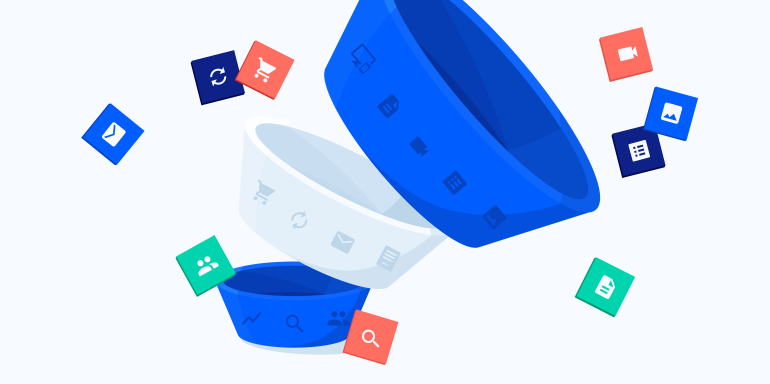- Defining the advertising funnel
- Top of funnel advertising
- Native advertising
- Sponsored content
- Influencer advertising
- Display advertising
- Social media advertising
- Middle of funnel advertising
- Retargeting
- Email advertising
- Paid search
- Bottom of funnel advertising
- Content advertising
- Retargeting
- Why all funnel stages need post-click pages
- Conclusion
Most of the people in the market for your product won’t buy it. And that’s not because your product isn’t worth purchasing, but because there are so many competitors, products, and other categories of a solution, that the odds are against them picking you.
But there are ways to increase the likelihood they become a customer of yours. And it involves delivering the right advertising at the right stage of the buyer’s journey. To do it, you have to understand the advertising funnel.
Defining the advertising funnel
When discussing the buyer’s journey, it helps to have a way to visualize how prospects move through various stages to purchase. For over 100 years, the most common has been a funnel.
The first model of this kind was developed in 1898 by ad executive Elias St. Elmo Lewis. With just four stages, it attempted to sum up the relationship between business and consumer:
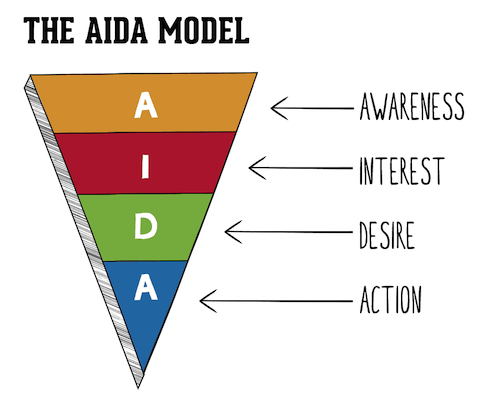
- Awareness: prospect becomes aware of products and categories that solve a problem
- Interest: prospect narrows down to particular product or category as a solution
- Desire: prospect shows desire to choose from a shortlist of brands
- Action: prospect chooses a solution
With a funnel shape, the model conveys the size of the audience between awareness and action. Prospects drop off little by little as they progress, leaving the funnel for other categories, products, and brands outside your own. A very few in comparison become customers.
But as established as this AIDA model is for advertisers and marketers, it doesn’t reflect what we know now about the path to purchase of the average buyer. Today, some new models attempt to paint a standardized picture of the relationship between business and consumer.
There’s the hourglass model:
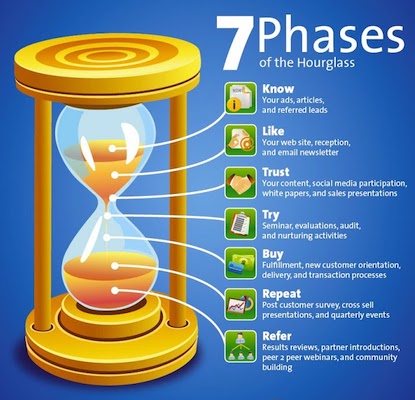
Forrester’s model that looks like a pipe maze:
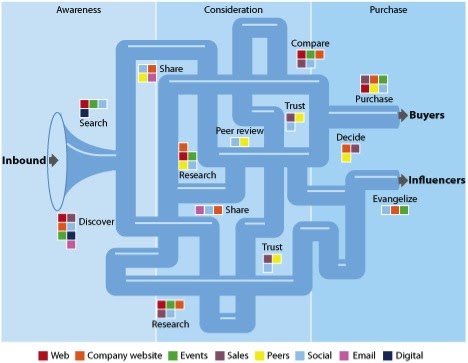
And others that continue the funnel but add some stages:
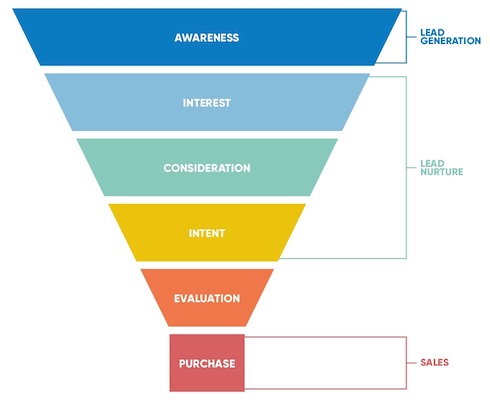
Like they did in 1898, consumers still drop off as they progress through decision-making stages of the buyer’s journey. So a funnel shape may not be so far off from reality. The AIDA funnel, however, is certainly outdated, especially considering research that shows it’s far more profitable to retain customers than it is to earn new ones. Since the AIDA funnel stops at the “action” stage, where prospects make a purchase, it doesn’t explore the relationship between business and customer. And by leaving that out, St. Elmo Lewis implies that when someone becomes a customer, your responsibilities as a business have ended. But that couldn’t be further from the truth.
Updated models, which include loyalty and advocacy after purchase, are closer to what a business should aim for at the bottom of the advertising funnel. Because when leads are loyal, they purchase again. And when they enjoy their relationship with your business enough, they will actually do your marketing for you by referring new customers. Since people take the opinions of their friends seriously, delighting customers can be worth quite a lot.
The old model did well to map the pre-purchase stages of the funnel, but today’s versions — like the one below — do a better job of covering the relationship after the purchase:
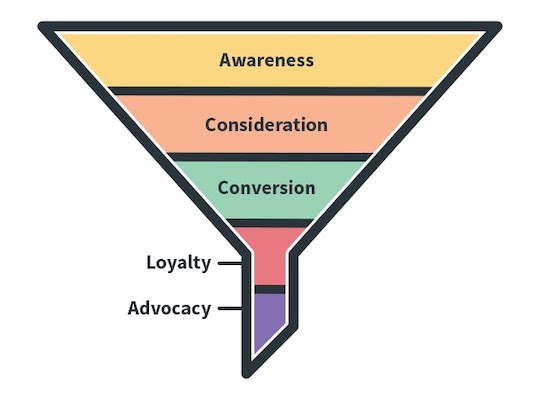
Stage by stage, top to bottom, here’s how the business/prospect relationship looks throughout the advertising funnel.
Top of funnel advertising
At the top of the funnel is where potential customers don’t know about your brand, and may even not know they have a problem you can solve. What does that mean? If you’ve ever watched infomercials, you understand: Who knew people would go crazy for a blanket with armholes? But if not for advertising, Snuggie wouldn’t have taken off.
At this point in the funnel is where you attempt to gain exposure to potential customers. The goal is to broaden your audience by casting a wide net. Knowing that most people will abandon your funnel later, you want to maximize the number of people you get at the top. That doesn’t mean disseminating your message to anyone who will hear it, though. It involves carefully researching where your audience spends time and running ads in those places to keep your brand top-of-mind. For this purpose, the following tactics work well.
Native advertising
Native advertisements, like sponsored videos or advertorials, can be great ways to expose your brand to a new audience without being too invasive. These are formatted in a way that blends with surrounding content on the platform, hence the name “native.” The idea is if the ad content is designed like the content visitors are there to consume, there’s a better chance they respond positively to it. This can be true, as long as the brand voice suits the publisher it’s advertising on.
Sponsored content
Sponsored content can be a native advertisement, but not all sponsored content is native advertising. So the distinction is important to make. If you find your audience consumes a particular newsletter, for example, you might consider “sponsoring” a mailing by contributing to the brand that provides it in exchange for a mention.
Here’s an example from the NextDraft newsletter of a mailing sponsored by Firefox:
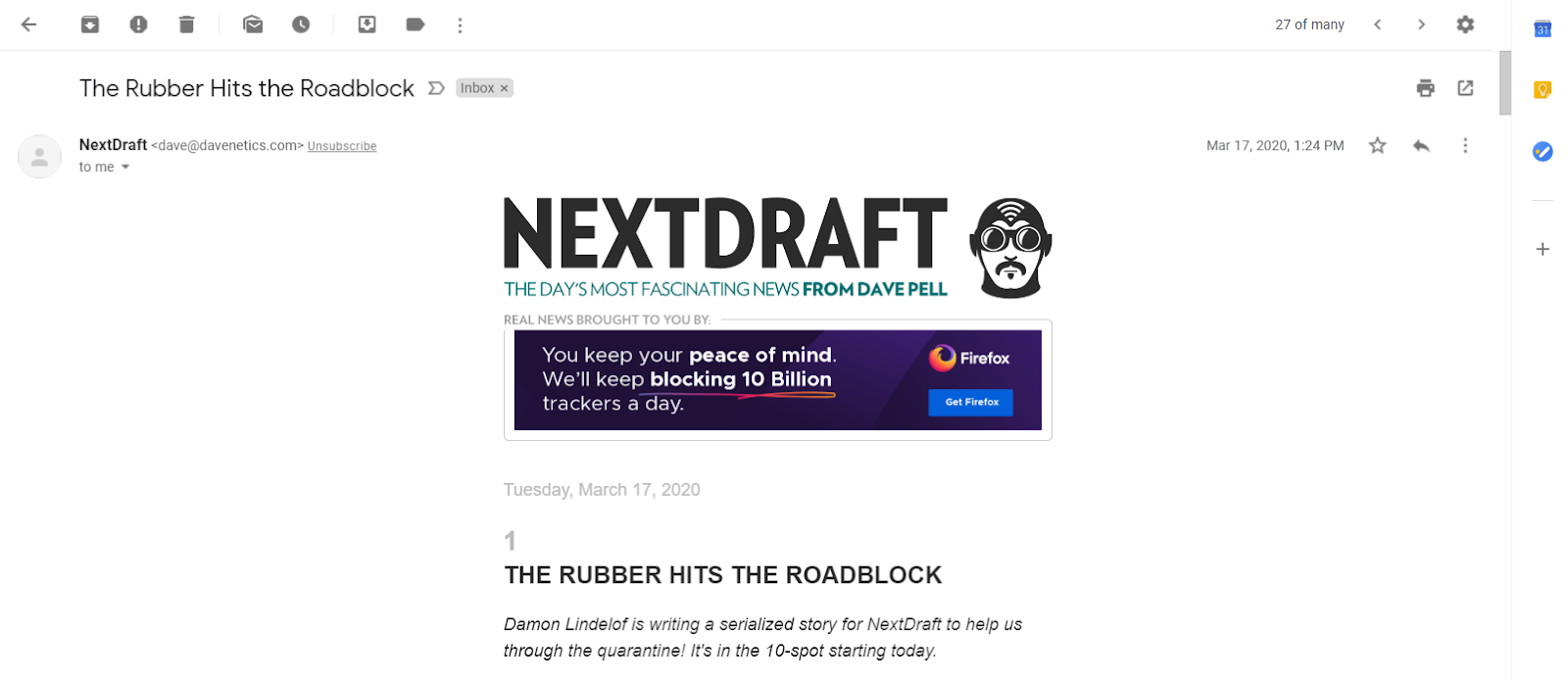
Influencer advertising
Particularly big on Instagram, influencer advertising is a little like the democratizing of endorsements, where brands pay regular people with a following for audience exposure. If your brand aligns with the content of someone with a following — whether that’s on Instagram or any other network, including a blog — compensating influencers for a mention in their content can do well to get you more attention at the top of the funnel.
Display advertising
With a wide reach and narrow targeting options, display networks can get your brand in front of the majority of internet users. This makes them particularly useful for driving brand awareness. Not only that, but they can be particularly engaging. Where sponsored content aims to blend in, display ads use color and text to stand out.
Social media advertising
Of all the online places people spend their time, most are on social media. This makes it a particularly great place to spread awareness. Since most are on social media to be social, and not to consume branded content, social media ads should stand out from the platform they’re on and offer something particularly engaging with little expectation of what they’ll get in return. Here’s an example of a social media ad from Human Interest that offers a guide while asking for little in return:
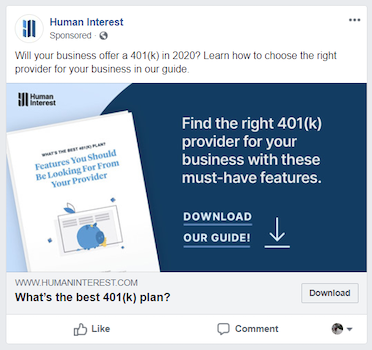
Middle of funnel advertising
By the middle of the funnel, prospects have expressed an interest in your brand in some way. There are lots of ways they can do this: reading a sponsored article, clicking through to a post-click landing page, engaging with your social media ad, etc.
At this point, your responsibility changes from making consumers aware of your brand to guiding them to a decision. And it’s important to clarify that this “decision” isn’t the decision to buy your product. The goal isn’t necessarily to persuade but to educate. If you focus on telling your leads what they want to hear, like, “Our solution is fit for businesses of all sizes!” when you know that only enterprises can afford your software, you risk wasting money on nurturing a lead that would never have become a customer anyway. And even if they did become a customer, it’s less likely they are to be satisfied than those closer to your ideal customer profile.
So throughout the interest and desire stages, the job of the advertiser is to educate, honestly, on the product so that leads can make an informed buying decision. Known as nurturing, this process involves ads and landing pages that offer various types of offers. Most often, those offers are for content, but they don’t have to be.
Retargeting
Though some say it’s creepy, data would disagree. The more people view retargeting ads, the more likely they are to respond well to them. Retargeting ads are for the people who have expressed interest in your brand by visiting a particular page. Be it a blog post, a landing page, a product page, etc., retargeting can provide a personalized ad to draw them back.
Email advertising
It was once the case that you needed an email address to get into a prospect’s inbox. No longer. With ads like those from Gmail, you can inject advertising messages into the inboxes of people who may have a need for your product. Here’s an example of a Gmail ad from Visible:
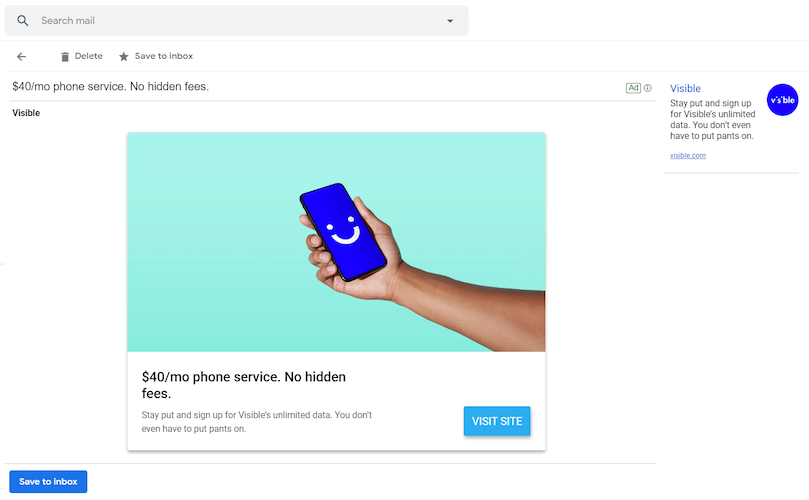
Paid search advertising
One of the biggest changes between the time of the old AIDA funnel and today’s versions is the power of the consumer. More now than ever, the average person can drop into the funnel wherever they want. This is where paid search ads come in.
When prospects know they have a problem that needs a solution, they turn to a search engine like Google. A person like this carries with them what’s known as “intent.” They intend to find a solution to their problem as opposed to someone at the top of the funnel, which is unaware that they have a problem, or that a solution exists. Paid search ads are a great way to capitalize on intent to provide searchers with an answer they are seeking at the time of their search. Here are some examples of paid search ads for the query “small business legal help.”
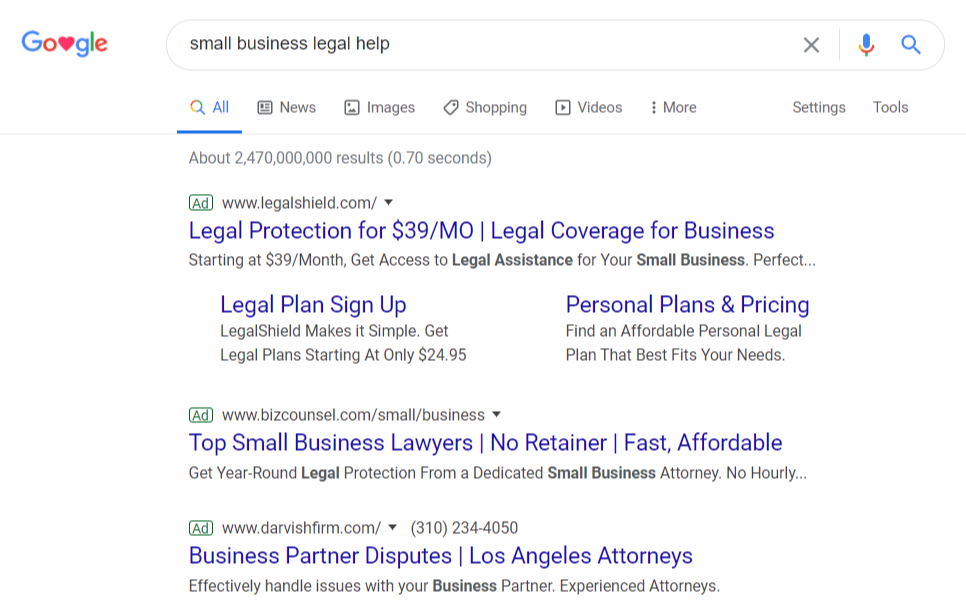
Bottom of funnel advertising
Since the funnel has grown from its original four stages, “the bottom” takes up a lot more than it once did. Spanning the action stages through advocacy, this is where your lead makes the decision to buy and whether or not to buy again, or to recommend your product to friends, family, and colleagues.
Early in the bottom of the funnel, the content is more tailored to the customer’s specific needs, and it proves that the business is capable of meeting those needs. This could be:
Content advertising
At all stages of the funnel, content advertising can be valuable, but no more than the bottom. Here’s where proof comes into play.
Reports prove that the business is an authority, testimonials tout the solutions of the provider, and case studies prove the business can solve problems similar to the one faced by the prospect. Once they’re customers, content like blog posts and emails can ensure visitors use the product to its potential. And when they can use your product well, they are more likely to be satisfied and loyal. Email newsletters and user-generated content are just two forms of content that you can advertise via social media, display, email, and more.
Here’s an example of a content ad that attempts to generate a high-intent lead (a lead that is more inclined to buy because they are looking specifically for a content solution):
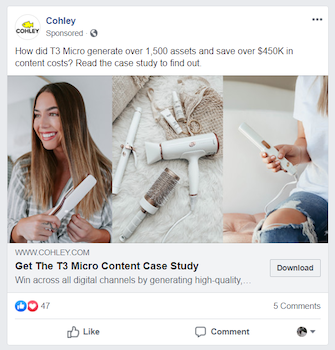
Retargeting
Retargeting is useful to elicit the purchase. But not just the first purchase. Satisfied, loyal customers are more likely to buy add-ons, upgrades, and even other products. Reach your prospects on social media like Facebook and Instagram, and through display ad networks like Google Ads.
Why all funnel stages need post-click landing pages
The AIDA stages aren’t the only outdated aspect of the funnel model. When advertisers think “digital advertising,” they think mostly of ad formats and networks. While networks and formats are central to campaign success, they’re no longer relied on as they once were to drive ROI.
Now, the post-click landing page is where conversion happens. It’s where leads are generated, qualified, and where sales are made. To maintain the highest level of campaign relevance, every audience should have its own post-click landing page. Every personalized ad should drive traffic to a personalized post-click landing page at each stage of the funnel:
Squeeze pages
At the top of the funnel, squeeze pages are lead-generation powerhouses driven by the concept that you can give away a lot for little in return. These pages ask only email, or name and email, and in return, give away valuable content.
Lead capture landing pages
Lead capture pages are valuable at the top, middle, and even bottom of the funnel. These pages feature forms made of fields that sales and marketing have determined. Together, marketing and sales ask: Who is our ideal customer? What questions do we have to ask to find this customer? These forms are built based on that.
Ebook, webinar, report, demo landing pages
Landing pages like these offer content throughout the funnel. Ebook landing pages are valuable at the top of the funnel, since the content is usually easily digestible. Webinar landing pages are valuable at the top and bottom of the funnel for boosting authority, and the same is true of the report landing page. Demo landing pages are more valuable at the bottom of the funnel, where visitors are looking for specific indicators that a platform/service can solve their problems, and a business is looking to prove it.
Sales pages & checkout pages
Checkout pages are ecommerce pages that feature a form, which attempts to get visitors to purchase items in their cart. These are particularly valuable at the bottom of the funnel, as pages that catch traffic from retargeting ads.
Sales pages, aka click-through landing pages, on the other hand, are usually reserved for B2B businesses (or B2C businesses that are expensive or high-commitment). These are much longer, comprehensive pages that contain lots of social proof: testimonials, authority indicators, security badges — along with well-written content that overcomes the most common buying objections.
The advertising funnel needs post-click landing pages
Understanding the funnel is one thing, but using it effectively is something completely different. It’s important to remember that an advertisement is only as good as the page it drives traffic to. That’s why every post-click landing page needs to be as personalized as the ad it comes from. To accomplish that, you need to be able to scale post-click landing page creation. It must be as easy to create landing pages as it is to create ads. And the only way that’s possible is with Instapage. Find out how you can personalize every post-click landing page with the industry’s only post-click automation platform. Claim an Enterprise demo here.

See the Instapage Enterprise Plan in Action.
Demo includes AdMap™, Personalization, AMP,
Global Blocks, heatmaps & more.
